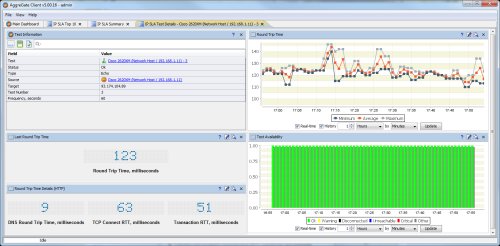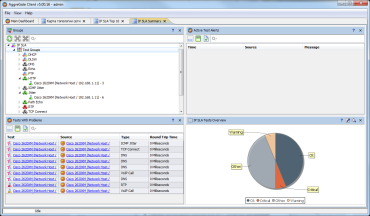IP SLA Management and WAN Link Monitoring
Monitoring availability, reliability and performance of WAN links (logical connections between two geographically distant network hosts) is essential for all enterprises. We'll try to be succinct here. Remote branches of large multi-office corporations will severely suffer if elements of the IT infrastructure located in HQ become unavailable. Those corporations rarely own WAN channels – these channels are normally rented from telecom operators. All channel quality complaints will be forwarded to the telecoms who will need even better link monitoring service for proactively solving quality degradation issues and planning capacity.
AggreGate Network Manager offers different methods of WAN link monitoring:
- ICMP/UDP ping and visual route tracing
- Monitoring using Cisco IP SLA technology
- Control via hardware and software probes
The status and performance of monitored links can be visualized on network overview dashboards and geographical maps created in the integrated UI Builder.
Basic Monitoring: Ping and Route Tracing
The simplest WAN Link monitoring tools are ping and traceroute commands known to any network administrator. The Network Manager can automate such basic monitoring by:
- Performing periodic ICMP or UDP ping of remote hosts
- Collecting and visualizing round-trip time (RTT), packet loss and availability statistics
- Running scheduled route tracing
- Visually representing hop-by-hop routes, including RTT values
- Alerting upon route changes (new/disappeared hops, existence or absence of certain hops, RTT threshold violation for intermediate hops)
- Performing measurements from diverse locations by different servers of a distributed installation
IP SLA Monitoring and Management
Cisco IP SLA technology enables Cisco routers and switches to perform various network tests by exchanging simulated data with other Cisco devices ("responders") or ordinary network hosts.
IP SLA ensures monitoring of:
- Leased line parameters (e.g., latencies and error rate)
- VoIP sound quality (jitter, MOS, etc.)
- Video stream and IPTV quality
AggreGate Network Manager fully supports the following IP SLA test types: ICMP Echo, ICMP Path Echo, UDP Echo, TCP Connect, UDP Jitter, ICMP Path Jitter, VoIP Call, RTP, DNS, DHCP, FTP, HTTP.
AggreGate Network Manager is the only product allowing building custom tests through the central monitoring server by manually specifying a test protocol and all configuration parameters (over 50 parameters in total).
Features of IP SLA monitoring module
- Import of existing IP SLA tests from Cisco devices
- Batch creation of new IP SLA tests inside Cisco devices through the central monitoring server
- Updates and removal of tests through the central server
- Support for all types of IP SLA tests
- Support for the full set of test parameters
- Support for monitoring the full set of test metrics
- Out-of-the-box IP SLA infrastructure dashboards
- Hop-by-hop visualization of path tests
- Pre-configured IP SLA violation alerts
Probe-Based WAN Channel Monitoring
AggreGate Network Manager can collect the network link measurement statistics from diverse network probes. Those probes can be custom-build hardware devices or software applications (usually running on industrial or micro PCs) from different manufacturers. Most probes support SNMP making their integration with the Network Manager extremely quick and easy. However, the underlying AggreGate IoT Platform ensures that all possible data collection methods are supported (see connectivity).
Probe-based monitoring has its advantages:
- No Cisco IP SLA enabled devices are required.
- Some probes can provide monitoring of neighboring physical channels (Ethernet, Wi-Fi and other OSI layer 1/2 technologies) in addition to WAN link monitoring.
- Advanced network demarcation devices can perform in-service testing of the real WAN channel bandwidth according to RFC2544.
- Specialized probes (such as IPTV/IP Video probes) can provide in-depth analysis and reporting for specific application protocols.




